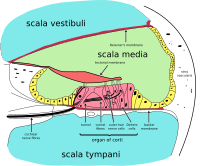
Photo from wikipedia
INTRODUCTION Congenital toxoplasmosis is an infectious disease with high prevalence in tropical countries. It is characterized by neurological, ophthalmological and auditory sequelae. OBJECTIVE The aim of this study was to… Click to show full abstract
INTRODUCTION Congenital toxoplasmosis is an infectious disease with high prevalence in tropical countries. It is characterized by neurological, ophthalmological and auditory sequelae. OBJECTIVE The aim of this study was to evaluate and describe the brainstem auditory evoked potential in infants aged 1-3 months diagnosed with congenital toxoplasmosis and to compare them with infants of the same age group without the infection. METHODS This is an observational, analytical and cross-sectional study in which brainstem auditory evoked potential was investigated in infants with congenital toxoplasmosis. The following audiological exams were performed: transient-evoked otoacoustic emissions, clinical and automatic brainstem auditory evoked potential. RESULTS 100 children participated in the study, but the final sample consisted of 76 children. Of the 37 children with toxoplasmosis included in the study, 28 completed the neurological imaging evaluation, and of these, 3 (10.7%) showed an altered neurological examination. At the brainstem auditory evoked potential assessment, two children without toxoplasmosis and 10 children with congenital toxoplasmosis had results suggestive of alterations in the brainstem auditory pathway maturation. CONCLUSION 10 (27%) children were identified with a possible unilateral alteration in the electrophysiological assessment. There was a 5-fold higher risk for a child between 1 and 3 months of age with toxoplasmosis to have an altered brainstem auditory evoked potential compared to a child of the same age range without the infection.
Journal Title: Brazilian journal of otorhinolaryngology
Year Published: 2018
Link to full text (if available)
Share on Social Media: Sign Up to like & get
recommendations!